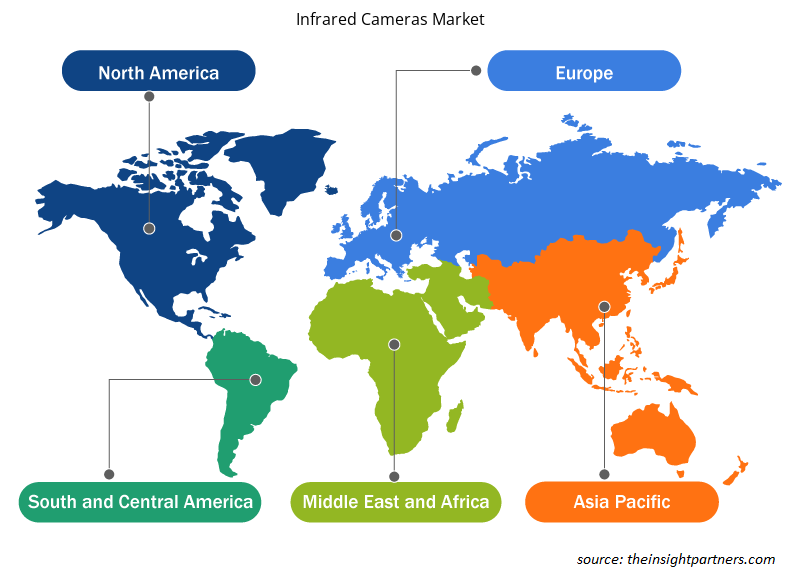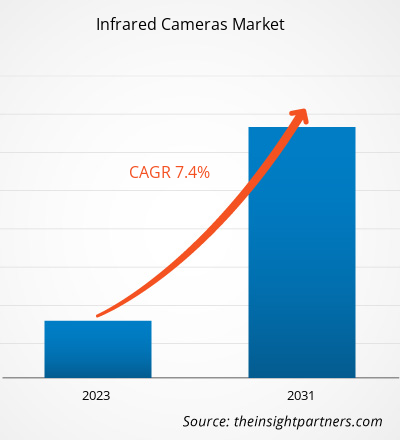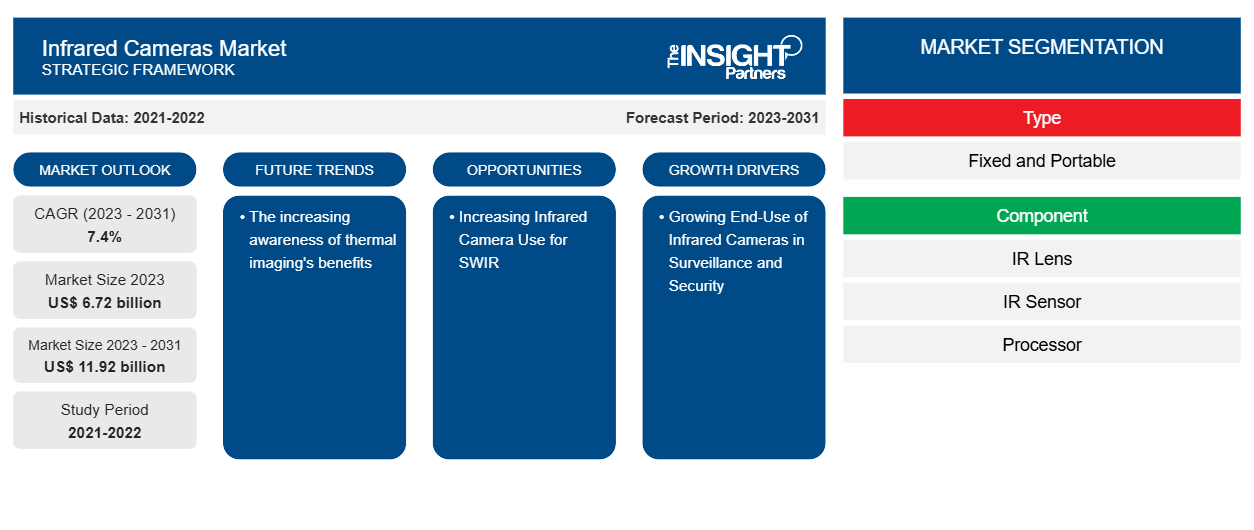Si prevede che il mercato delle telecamere a infrarossi raggiungerà 11,92 miliardi di dollari entro il 2031, passando dai 6,72 miliardi di dollari del 2023. Si prevede che il mercato registrerà un CAGR del 7,4% nel 2023-2031.La crescente consapevolezza dei vantaggi della termografia continuerà probabilmente a essere una tendenza fondamentale nel mercato delle telecamere a infrarossi.
Analisi di mercato delle telecamere a infrarossi
Il mercato delle telecamere a infrarossi è cresciuto notevolmente in tutto il mondo grazie a una varietà di utilizzi in settori tra cui sanità, automotive e sicurezza. Fornendo misurazione della temperatura senza contatto, visione notturna e identificazione dei difetti, le telecamere a infrarossi migliorano l'efficacia operativa. Grazie ai miglioramenti tecnologici, le telecamere con una migliore qualità delle immagini sono ora più piccole e hanno un prezzo più ragionevole. Man mano che più settori comprendono i vantaggi dell'imaging a infrarossi per l'efficienza energetica, la sorveglianza e la manutenzione predittiva, il mercato è pronto per una crescita futura. Tuttavia, ci sono ancora problemi con la regolamentazione e la concorrenza che influenzano le dinamiche di mercato. Si prevede che l'innovazione in corso e il crescente utilizzo industriale manterranno la tendenza al rialzo del mercato.
Panoramica del mercato delle telecamere a infrarossi
Le telecamere a infrarossi sono ampiamente utilizzate in applicazioni di sorveglianza e sicurezza. Anche in totale oscurità, sono comunque in grado di rilevare il movimento e scattare foto termiche. Possono quindi essere utilizzate per tenere d'occhio grandi spazi, individuare intrusi e fermare furti e vandalismi.
Inoltre, integrando queste telecamere con analisi video all'avanguardia, è possibile rafforzare l'identificazione delle minacce e i protocolli di sicurezza generali. La tecnologia Smart IR è inclusa in alcune telecamere di sicurezza. Questo metodo elimina il problema di un oggetto troppo luminoso regolando la luminosità dei LED a infrarossi in base alla distanza dell'oggetto dalla telecamera. Risolve il problema dei LED a infrarossi che oscurano le foto quando gli oggetti sono in prossimità della telecamera
Personalizza questo report in base alle tue esigenze
Riceverai la personalizzazione gratuita di qualsiasi report, comprese parti di questo report, o analisi a livello nazionale, pacchetto dati Excel, oltre a usufruire di grandi offerte e sconti per start-up e università
- Scopri le principali tendenze di mercato in questo rapporto.Questo campione GRATUITO includerà analisi di dati che spaziano dalle tendenze di mercato alle stime e alle previsioni.
Driver e opportunità del mercato delle telecamere a infrarossi
Crescente utilizzo finale delle telecamere a infrarossi nella sorveglianza e nella sicurezza
La sicurezza pubblica riceve la massima attenzione in tutto il mondo. I gruppi per la sicurezza pubblica stanno investendo in una varietà di tecnologie all'avanguardia per garantire l'efficacia. In risposta all'aumento della criminalità, dei comportamenti antisociali e degli attacchi terroristici, il governo ha messo in atto tecnologie innovative e misure di sicurezza. Ora è essenziale creare soluzioni praticabili, sicure e accessibili, nonché migliorare la capacità del sistema di rispondere ad attacchi catastrofici.
Inoltre, una varietà di telecamere a infrarossi viene utilizzata per la sorveglianza perimetrale, l'applicazione della legge, la sicurezza interna e il monitoraggio della difesa. Il mercato sta crescendo grazie a funzionalità migliorate come grandi prestazioni, capacità di imaging migliorate e alta affidabilità. Per stabilire un sistema di sorveglianza completo, queste telecamere possono anche essere collegate a dispositivi di posizionamento pan e tilt.
Aumento dell'uso della telecamera a infrarossi per SWIR
Le principali applicazioni per le telecamere a infrarossi raffreddate sono lunghe e medie distanze. Tuttavia, con l'avanzare della tecnologia, queste telecamere a infrarossi vengono utilizzate per applicazioni più ravvicinate. Le matrici del piano focale InGaAs con bassa corrente oscura e scarso numero di pixel vengono utilizzate nelle telecamere a infrarossi raffreddate. Le telecamere a infrarossi vengono utilizzate per le misurazioni di metrologia SWIR per applicazioni finali a corto raggio. Inoltre, queste telecamere a infrarossi a corto raggio consentono bassi livelli di rumore a circa 220 fotogrammi al secondo. Numerose aziende stanno sviluppando prodotti per lunghezze d'onda medie e lunghe, nonché per brevi distanze. Per una varietà di applicazioni, le telecamere a infrarossi per SWIR migliorano la vista e incoraggiano il raffreddamento passivo. Si prevede che queste telecamere a corto raggio vengano utilizzate per la profilazione del raggio laser, la spettroscopia , l'imaging iperspettrale e l'ispezione dei semiconduttori.
Analisi della segmentazione del rapporto di mercato delle telecamere a infrarossi
I segmenti chiave che hanno contribuito alla derivazione dell'analisi di mercato delle telecamere a infrarossi sono tipologia, componente, lunghezza d'onda e applicazione.
- In base all'offerta, il mercato delle telecamere a infrarossi è segmentato in fisso e portatile. Il segmento fisso ha detenuto una quota di mercato maggiore nel 2023.
- In base ai componenti, il mercato è segmentato in lenti IR, sensori IR, processori e altri.
In base alla lunghezza d'onda, il mercato è segmentato inLWIR , MWIR , NIR e SWIR .
Per applicazione, il mercato è segmentato in elettronica di consumo, sicurezza e sorveglianza, aerospaziale e difesa e altri. Il segmento sicurezza e sorveglianza ha detenuto una quota di mercato maggiore nel 2023.
Analisi della quota di mercato delle telecamere a infrarossi per area geografica
L'ambito geografico del rapporto di mercato sulle telecamere a infrarossi è principalmente suddiviso in cinque regioni: Nord America, Asia Pacifico, Europa, Medio Oriente e Africa e Sud America/Sud e Centro America. In termini di fatturato, l'APAC ha rappresentato la quota di mercato più grande per le telecamere a infrarossi. Poiché la necessità di sistemi di sicurezza e sorveglianza è cresciuta, le aziende di una vasta gamma di settori hanno iniziato a comprendere quanto siano importanti le telecamere a infrarossi per garantire un rilevamento efficiente. Grazie alla disponibilità di tecnologie sofisticate e aggiornate, all'aumento della domanda di elettronica intelligente e all'espansione del settore industriale, questo è il mercato più redditizio per le telecamere a infrarossi.
Approfondimenti regionali sul mercato delle telecamere a infrarossi
Le tendenze regionali e i fattori che influenzano il mercato delle telecamere a infrarossi durante il periodo di previsione sono stati ampiamente spiegati dagli analisti di Insight Partners. Questa sezione discute anche i segmenti e la geografia del mercato delle telecamere a infrarossi in Nord America, Europa, Asia Pacifico, Medio Oriente e Africa e America meridionale e centrale.

- Ottieni i dati specifici regionali per il mercato delle telecamere a infrarossi
Ambito del rapporto di mercato sulle telecamere a infrarossi
| Attributo del report | Dettagli |
|---|---|
| Dimensioni del mercato nel 2023 | 6,72 miliardi di dollari USA |
| Dimensioni del mercato entro il 2031 | 11,92 miliardi di dollari USA |
| CAGR globale (2023-2031)CAGR (2023 - 2031) | 7,4% |
| Dati storici | 2021-2022 |
| Periodo di previsione | 2023-2031 |
| Segmenti coperti | Per tipo
|
| Regioni e Paesi coperti | America del Nord
|
| Leader di mercato e profili aziendali chiave |
|
Densità dei player del mercato delle telecamere a infrarossi: comprendere il suo impatto sulle dinamiche aziendali
Il mercato delle telecamere a infrarossi sta crescendo rapidamente, spinto dalla crescente domanda degli utenti finali dovuta a fattori quali l'evoluzione delle preferenze dei consumatori, i progressi tecnologici e una maggiore consapevolezza dei vantaggi del prodotto. Con l'aumento della domanda, le aziende stanno ampliando le loro offerte, innovando per soddisfare le esigenze dei consumatori e capitalizzando sulle tendenze emergenti, il che alimenta ulteriormente la crescita del mercato.
La densità degli operatori di mercato si riferisce alla distribuzione di aziende o società che operano in un particolare mercato o settore. Indica quanti concorrenti (operatori di mercato) sono presenti in un dato spazio di mercato in relazione alle sue dimensioni o al valore di mercato totale.
Le principali aziende che operano nel mercato delle telecamere a infrarossi sono:
- Leonardo
- Opgal Optronic Industries Ltd
- Teledyne DALSA
- Cerca Thermal, Inc.
- LINREDO
- Sistemi Thermoteknix Ltd
Disclaimer : le aziende elencate sopra non sono classificate secondo un ordine particolare.

- Ottieni una panoramica dei principali attori del mercato delle telecamere a infrarossi
Notizie di mercato e sviluppi recenti sulle telecamere a infrarossi
Il mercato delle telecamere a infrarossi viene valutato raccogliendo dati qualitativi e quantitativi dopo la ricerca primaria e secondaria, che include importanti pubblicazioni aziendali, dati di associazioni e database. Di seguito è riportato un elenco degli sviluppi nel mercato dei disturbi del linguaggio e della parola e delle strategie:
- A gennaio 2024, Samsung Electronics ha presentato Galaxy S24 Ultra, S24+ e S24, promettendo nuove esperienze mobili con Galaxy AI. La serie Galaxy S intende ripensare il rafforzamento del client con l'AI. Offre punti salienti come interpretazioni intelligenti di testo e chiamate per una comunicazione coerente, libertà creativa migliorata tramite ProVisual Engine e capacità di ricerca ulteriormente sviluppate per trovare il mondo che li circonda. (Fonte: Samsung Electronics, comunicato stampa)
- Nel gennaio 2024, Valeo e Teledyne FLIR, una divisione di Teledyne Technologies Incorporated, hanno avviato una partnership strategica per introdurre l'innovazione della termografia nel settore automobilistico, con l'obiettivo di sviluppare ulteriormente la sicurezza degli utenti della strada. (Fonte: Valeo, comunicato stampa)
Copertura e risultati del rapporto di mercato sulle telecamere a infrarossi
Il rapporto "Dimensioni e previsioni del mercato delle telecamere a infrarossi (2021-2031)" fornisce un'analisi dettagliata del mercato che copre le seguenti aree:
- Dimensioni e previsioni del mercato a livello globale, regionale e nazionale per tutti i segmenti di mercato chiave coperti dall'ambito
- Dinamiche di mercato come fattori trainanti, vincoli e opportunità chiave
- Principali tendenze future
- Analisi dettagliata delle cinque forze PEST/Porter e SWOT
- Analisi di mercato globale e regionale che copre le principali tendenze di mercato, i principali attori, le normative e gli sviluppi recenti del mercato
- Analisi del panorama industriale e della concorrenza che copre la concentrazione del mercato, l'analisi della mappa di calore, i principali attori e gli sviluppi recenti
- Profili aziendali dettagliati
- Analisi storica (2 anni), anno base, previsione (7 anni) con CAGR
- Analisi PEST e SWOT
- Valore/volume delle dimensioni del mercato - Globale, Regionale, Nazionale
- Industria e panorama competitivo
- Set di dati Excel
Report recenti
Testimonianze
Motivo dell'acquisto
- Processo decisionale informato
- Comprensione delle dinamiche di mercato
- Analisi competitiva
- Analisi dei clienti
- Previsioni di mercato
- Mitigazione del rischio
- Pianificazione strategica
- Giustificazione degli investimenti
- Identificazione dei mercati emergenti
- Miglioramento delle strategie di marketing
- Aumento dell'efficienza operativa
- Allineamento alle tendenze normative





















 Ottieni un campione gratuito per - Mercato delle telecamere a infrarossi
Ottieni un campione gratuito per - Mercato delle telecamere a infrarossi